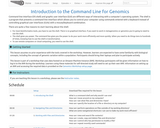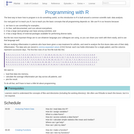
Data Carpentry lesson to learn to navigate your file system, create, copy, move, and remove files and directories, and automate repetitive tasks using scripts and wildcards with genomics data. Command line interface (OS shell) and graphic user interface (GUI) are different ways of interacting with a computer’s operating system. The shell is a program that presents a command line interface which allows you to control your computer using commands entered with a keyboard instead of controlling graphical user interfaces (GUIs) with a mouse/keyboard combination. There are quite a few reasons to start learning about the shell: For most bioinformatics tools, you have to use the shell. There is no graphical interface. If you want to work in metagenomics or genomics you’re going to need to use the shell. The shell gives you power. The command line gives you the power to do your work more efficiently and more quickly. When you need to do things tens to hundreds of times, knowing how to use the shell is transformative. To use remote computers or cloud computing, you need to use the shell.
- Subject:
- Applied Science
- Computer Science
- Genetics
- Information Science
- Life Science
- Mathematics
- Measurement and Data
- Material Type:
- Module
- Provider:
- The Carpentries
- Author:
- Amanda Charbonneau
- Amy E. Hodge
- Anita Schürch
- Bastian Greshake Tzovaras
- Bérénice Batut
- Colin Davenport
- Diya Das
- Erin Alison Becker
- François Michonneau
- Giulio Valentino Dalla Riva
- Jessica Elizabeth Mizzi
- Karen Cranston
- Kari L Jordan
- Mattias de Hollander
- Mike Lee
- Niclas Jareborg
- Omar Julio Sosa
- Rayna Michelle Harris
- Ross Cunning
- Russell Neches
- Sarah Stevens
- Shannon EK Joslin
- Sheldon John McKay
- Siva Chudalayandi
- Taylor Reiter
- Tobi
- Tracy Teal
- Tristan De Buysscher
- Date Added:
- 08/07/2020
